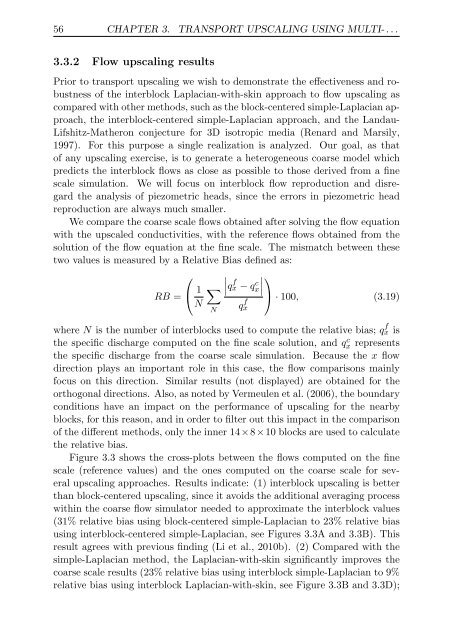Upscaling and Inverse Modeling of Groundwater Flow and Mass ...
Upscaling and Inverse Modeling of Groundwater Flow and Mass ...
Upscaling and Inverse Modeling of Groundwater Flow and Mass ...
You also want an ePaper? Increase the reach of your titles
YUMPU automatically turns print PDFs into web optimized ePapers that Google loves.
56 CHAPTER 3. TRANSPORT UPSCALING USING MULTI- . . .<br />
3.3.2 <strong>Flow</strong> upscaling results<br />
Prior to transport upscaling we wish to demonstrate the effectiveness <strong>and</strong> robustness<br />
<strong>of</strong> the interblock Laplacian-with-skin approach to flow upscaling as<br />
compared with other methods, such as the block-centered simple-Laplacian approach,<br />
the interblock-centered simple-Laplacian approach, <strong>and</strong> the L<strong>and</strong>au-<br />
Lifshitz-Matheron conjecture for 3D isotropic media (Renard <strong>and</strong> Marsily,<br />
1997). For this purpose a single realization is analyzed. Our goal, as that<br />
<strong>of</strong> any upscaling exercise, is to generate a heterogeneous coarse model which<br />
predicts the interblock flows as close as possible to those derived from a fine<br />
scale simulation. We will focus on interblock flow reproduction <strong>and</strong> disregard<br />
the analysis <strong>of</strong> piezometric heads, since the errors in piezometric head<br />
reproduction are always much smaller.<br />
We compare the coarse scale flows obtained after solving the flow equation<br />
with the upscaled conductivities, with the reference flows obtained from the<br />
solution <strong>of</strong> the flow equation at the fine scale. The mismatch between these<br />
two values is measured by a Relative Bias defined as:<br />
RB =<br />
⎛<br />
⎝ 1<br />
N<br />
�<br />
�<br />
∑ �q f x − qc �<br />
�<br />
⎞<br />
x�<br />
⎠ · 100, (3.19)<br />
N<br />
where N is the number <strong>of</strong> interblocks used to compute the relative bias; q f x is<br />
the specific discharge computed on the fine scale solution, <strong>and</strong> q c x represents<br />
the specific discharge from the coarse scale simulation. Because the x flow<br />
direction plays an important role in this case, the flow comparisons mainly<br />
focus on this direction. Similar results (not displayed) are obtained for the<br />
orthogonal directions. Also, as noted by Vermeulen et al. (2006), the boundary<br />
conditions have an impact on the performance <strong>of</strong> upscaling for the nearby<br />
blocks, for this reason, <strong>and</strong> in order to filter out this impact in the comparison<br />
<strong>of</strong> the different methods, only the inner 14×8×10 blocks are used to calculate<br />
the relative bias.<br />
Figure 3.3 shows the cross-plots between the flows computed on the fine<br />
scale (reference values) <strong>and</strong> the ones computed on the coarse scale for several<br />
upscaling approaches. Results indicate: (1) interblock upscaling is better<br />
than block-centered upscaling, since it avoids the additional averaging process<br />
within the coarse flow simulator needed to approximate the interblock values<br />
(31% relative bias using block-centered simple-Laplacian to 23% relative bias<br />
using interblock-centered simple-Laplacian, see Figures 3.3A <strong>and</strong> 3.3B). This<br />
result agrees with previous finding (Li et al., 2010b). (2) Compared with the<br />
simple-Laplacian method, the Laplacian-with-skin significantly improves the<br />
coarse scale results (23% relative bias using interblock simple-Laplacian to 9%<br />
relative bias using interblock Laplacian-with-skin, see Figure 3.3B <strong>and</strong> 3.3D);<br />
q f x


